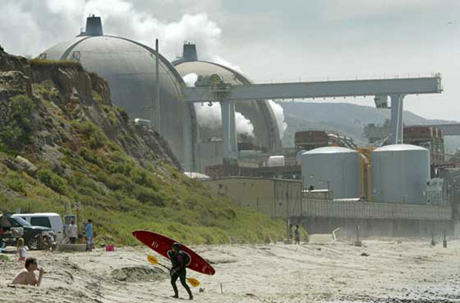Last Friday, Edison International—one of the largest investor-owned utilities in the country—announced that it would permanently retire the troubled San Onofre Nuclear Generating Station (SONGS). The decision ended 18 months of uncertainty for Southern California Edison (SCE) and San Diego Gas & Electric (SDG&E) customers, after a January 2012 leak caused the plant to be shut down.
Those of you who aren’t energy aficionados may recall SONGS from its cameo appearance in The Naked Gun, or from the last time you took a drive down the Pacific Coast Highway from Orange County to San Diego. At its peak, the 40-year-old plant powered about 20 percent of Southern California. The shutdown and now retirement of the plant has made our state’s energy future uncertain.
As if that’s not bad enough, SCE and SDG&E have already spent about $1.2 billion on repairing the facility and buying replacement power. Most if not all of those costs have been passed along to SCE and SDG&E ratepayers. And according to SCE’s own press release, 1,100 of those ratepayers are SONGS employees who will be laid off over the next year. So this development not only hurts the consumer, it also cripples the local economy.
And that’s before we talk about why the plant was closed in the first place. It turns out, a weakened tube in a generator system leaked radioactive steam into the atmosphere. Production was halted, the whole system was given a once over, and hundreds of weakened tubes were discovered. But no big deal, right? The plant had been functioning for four decades. These tubes were bound to wear down over time. Well, therein lies the rub.
The steam generator system that blew the leak had only been online since 2010. And nobody at Edison International or anywhere else could explain why it broke down so quickly. But instead of bending with the arc of history and using this incident as a rallying cry to move their business model toward more sustainable energy, the utility fought tooth-and-nail to reopen the plant, even lobbying the Nuclear Regulatory Commission, which finally told them something that big investor-owned utilities don’t hear very often from our government: “No.”
Edison International has laid the groundwork for legal action against the company that produced the faulty tubes. But where does that leave our fellow Californians in the southern part of the state as we approach peak months for energy use? Where can they go to recoup the $1.2 billion grabbed from their pockets to prop up behemoths like SCE and SDG&E, which turn hefty profits regardless of performance measures thanks to guaranteed rates of return? (I’m thinking of another three-letter abbreviation that starts with an S and ends with an L.)
Meanwhile, energy initiatives focused on the best interests of the consumer—like rooftop solar—are gaining ground quietly but steadily. Since 2009, two-thirds of California’s home solar installations have popped up in middle- and lower-income zip codes. It’s a trend that’s occurring not because of big utilities, but rather a band of innovative startups taking on the system. And now, with groups like The Alliance for Solar Choice (TASC) stepping up, we could be on the verge of an energy revolution. Rooftop solar is an important and necessary step in the right direction when it comes to replacing fossil fuels.
Unfortunately, SDG&E and other big California utilities don’t feel that way. As explained by Edward Fenster, CEO of Sunrun and a member of The Alliance for Solar Choice, utilities want to stop rooftop solar because it slows their growth. “Solar and energy efficiency are keeping per-capita energy consumption down,” said Fenster. “Utilities are fighting at the regulator to slow a disruptive technology.”
In SCE’s own press release, President Ron Litzinger said, “Looking ahead, we think that our decision to retire (SONGS) will eliminate uncertainty and facilitate orderly planning for California’s energy future.” To those of us living in the 21st Century, this sounds like a quote lifted from a 1980s Earth Day rally; a thoughtful, pro-active decision made by a progressive-minded energy company that’s actually concerned about the damage their industry is doing to our environment, our health, and our economy. But don’t be fooled.
Southern California Edison—and its parent company Edison International—won’t spend another moment facilitating “orderly planning” for our energy future. If they were seriously interested in going down that path, they would have taken it 40 years ago and invested in research and development of renewable energy resources, instead of throwing our money down the sinkhole that is San Onofre.
Peter Allen is an independent communications consultant, a city of San Jose arts commissioner and a proud native of Willow Glen.


Kind of ironic that they produce alternating current, but the company that produces it is named Edison. Edison and Tesla were fierce rivals.
Edison pushed for DC over AC citing safety concerns. He even went as far as to give live demonstrations of animals being electrocuted to death by AC to show the dangers of AC energy.
Just something that crossed my mind on my last trip to LA.